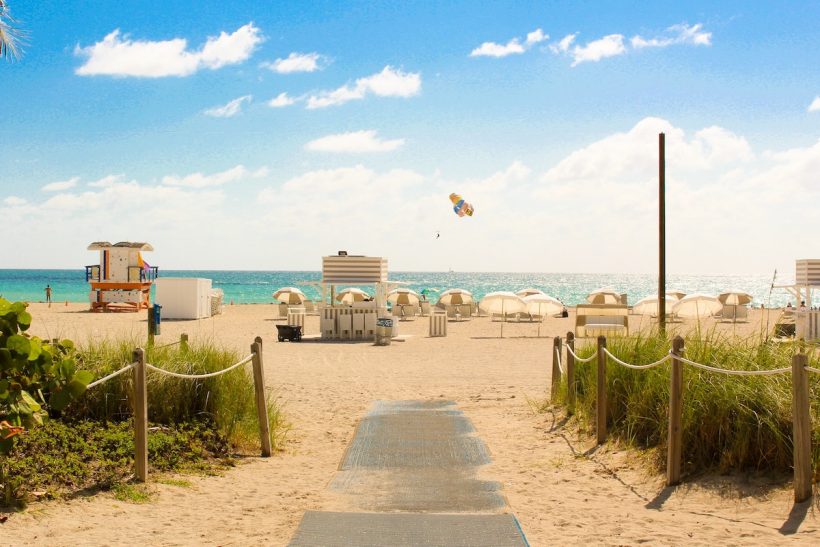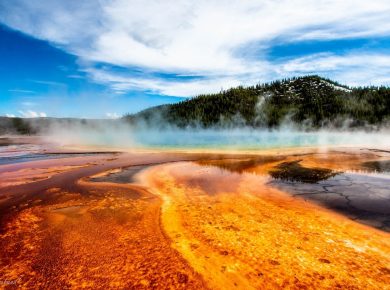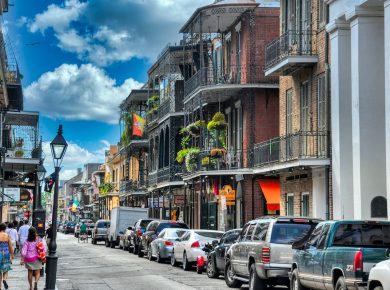Florida has endless opportunities to make your next vacation one of your most memorable. From beaches to theme parks and nightlife, it has everything to keep you entertained.
However, though attractions stay open year-round, does that mean it’s a good idea to visit any time? Though nicknamed The Sunshine State, it’s ever the weather wildcard. If you’re lucky enough to be spared of the brutal heat and humidity, you might have to run for cover from storms.
The best month to visit Florida is January when travel flights and hotels are the cheapest and the weather is the nicest. Crowds diminish, so you won’t feel the madness of peak season on your conscience or wallet. Alternatively, April is also known to have savings opportunities and slightly warmer weather.
The summer sun is no joke. Heat can be problematic no matter where you go. Central Florida is dotted with swamps, and it can feel swamp-like all over thanks to the humidity which sticks around for a long time. What happens if you go in the autumn for shoulder season?
You may have seen Disney World’s iconic Magic Kingdom closing and its castle lowered into the ground to brace for September 2022’s hurricane Ian. To avoid a situation like this, it’s crucial to book the right season.
Finding that perfect window can prove challenging, but it’s not impossible! This article assesses the average weather and tourist season trends to determine the best month to visit Florida for good weather and low prices.
To do this, we will look at state-wide weather patterns based on four cities: Miami on the southern tip, Jacksonville in the northeast, Tampa in the west, and Pensacola in the northwestern panhandle. Furthermore, we analyze tourism trends in these four cities to determine how traffic to the four cities reflects in pricing.
Table of Contents
Average Temperature In Florida
Florida’s temperatures can be summed up in one word: tropical. Its summers are hot and the winters are warm. Temperatures have only dropped below freezing in freak occurrences and many residents go a significant portion of their lives without owning a winter coat! Exactly how hot does it get there?
Tampa and Jacksonville are tied for the hottest average temperatures at 90°F in July. However, Tampa maintains that average from June through August while Jacksonville is about 2 degrees cooler in those months. Miami and Pensacola summers are hardly cooler! They both average 89°F at their peaks in July. Summer evenings feel like paradise by comparison. All four cities stay in the mid-to-upper 70s from June through August.
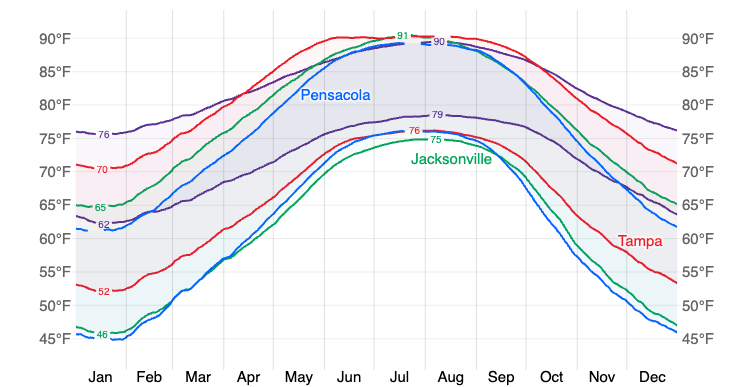
The cities vary a bit more in the wintertime. Pensacola gets the “coldest” winters, with average temperatures ranging from 61°F to 45°F in January. Jacksonville is slightly warmer with a January range of 65°F to 46°F.
Tampa and Miami are the places to be if you hate cold weather. January, Tampa’s coolest month, sees temperatures between 70°F and 52°F. Miami cranks up the heat even more to highs of 76°F and lows of 62°F.
Spring and autumn bring about rapid changes in temperatures across the state. Though the heat can be more agreeable, these changes often bring about unpleasant weather patterns, which we will explore in the next section.
Daily Chance Of Precipitation In Florida
It sounds unbecoming of The Sunshine State to be rainy, but Florida gets copious amounts of precipitation. Summertime is the wettest season, with increased chances of rain spanning May through October. However, the potential for rainy weather is always around the corner.
Tampa bears the heaviest rainfall in this list. The gulf coast city gets an average of 21.4 rainy days in the wettest month of July! The other three are tied for second, with about 17 wet days each.
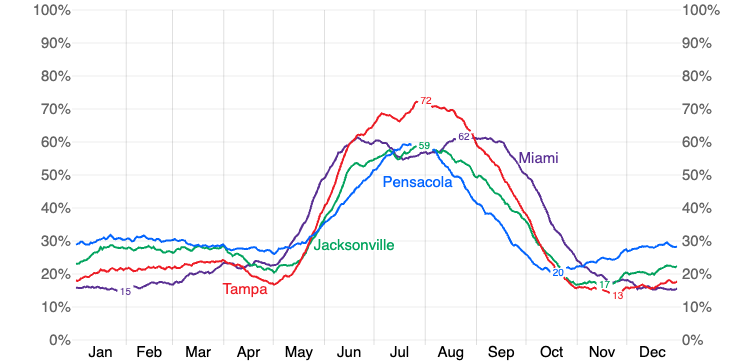
Outside the wet season, the chance of rain drops significantly with the cities ranging between a 10-30% chance of wet weather versus more than 60% in the summer. However, that doesn’t mean the chances of precipitation are insignificant.
Pensacola, for example, still gets about 9 rainy days in January. Jacksonville gets 8.2, Tampa 6.3, and Miami 4.8. Though the chances are significantly lower than in the summer, you’d be wise to pack a raincoat for any Florida trip. When it rains, it often pours. Four rainy days a month can mean a little drizzle, but in the case of Pensacola it can also mean up to 5 inches of rainfall in February.
Humidity Comfort Levels In Florida
With tropical temperatures comes tropical levels of humidity. Florida’s territory is 31% wetlands, so it should be no surprise that swampy, muggy weather is around for a good portion of the year.
The summer wet season is, by far, the most humid. All four cities reach a near 100% chance of humidity in July and August. This combined with temperatures over 90°F makes for brutal summer days that are less than ideal for walking around outside.
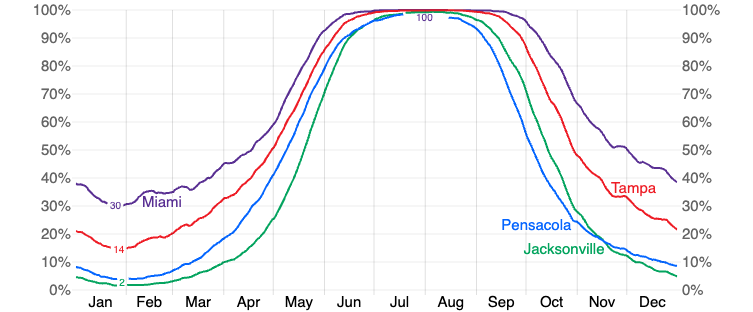
Even in the winter, Miami has between a 30% and 40% chance of muggy days. Tampa is calmer during this time with only 15-20% humidity. Pensacola and Jacksonville, on the other hand, get almost none in the wintertime! Between January and February, both cities have only a 2-3% chance.
Best Time Of Year To Visit Florida For Great Weather
With blistering heat, oppressive humidity, and crazy rainstorms, it would seem like there’s hardly a good time to visit Florida. This couldn’t be more wrong! There are a few times when you can be blessed with beautiful weather.
Geography plays a huge role, too. Not every city has the same conditions all year. Let’s look at the best time to visit Florida for good weather.
There are two factors used to decide the best months for weather called the “tourist score” and the “beach/pool score,” respectively. The first is used to determine how pleasurable outdoor activities like sightseeing tours are in a given month. Clear skies and temperatures between 65°F and 80°F are the criteria here.
Florida has its highest tourism scores in spring and fall because the summer temperatures and rain are too high. Miami is the highest scorer in this category, with a score of 7.4 in February. However, its score drops to 2.8 in August due to brutal conditions.
Between April and May, all four cities overlap at a tourist score of about 6.7, and they nearly overlap again in mid-October at the same score.
The “beach/pool score,” on the other hand, favors clear, sunny days with temperatures ranging between 75°F and 90°F. Those crazy hot summer months are better for these types of activities. However, due to the high rain in summer, May is the best month for chilling out by the beach. Miami takes the top spot once again with a 7.1 beach/pool score in May. The other three are close behind with scores between 6.1 and 6.5 in the same period.
Best Time Of Year To Visit Florida For Low Prices
Florida’s abundance of fun attractions and activities make it America’s vacation capital. People pour into the state every long weekend and break, making prices spike several times a year. However, if you can book at the right time, you can still manage to save on flights and accommodations!
You have countless airfare options since Florida has several large cities with busy airports. Some cities are cheaper to fly into than others. For instance, Fort Lauderdale is said to have the cheapest average ticket prices, and flying there instead of Miami could save you up to $50.
The cheapest months for flying to Florida are said to be January, May, early June, and September (watch out- September falls during hurricane season). If you’re lucky, a round-trip domestic flight will cost you around $100 in these months versus $250 or more in the high season.
However, you’re not limited to these months for deals anymore. Nowadays, budget carriers like Spirit, Frontier, and Allegiant have multiple routes to Florida from all across the USA. Though not always a popular choice, flying with one of these airlines could run you only $40 versus $200 or more with a larger carrier. Deals like these exist year-round!
The aforementioned months are also the best times to save on hotel reservations. When visiting in January, you can spend 50% less than what summertime tourists pay during the high season! Mid-range Miami hotels cost about $200 a night in January compared with late June when they’re over $300.
Peak Travel Season In Florida
With such high numbers of people choosing Florida for vacation, the intensity of peak season can always be felt. It’s difficult to tell when the tourist season ends in some areas because they’re full of different groups year-round.
For Central and Northern Florida, and also theme parks like Disney World and Universal Studios, peak season correlates with the school calendar. Summer break plus any long weekend sees these areas swell up with families. Prices will spike, so expect $300/night at a mid-range hotel to be a good deal.
Since most areas experience peak season during summer break, it also means that they get the most tourists during the hottest and rainiest time of the year. If crowds and unpleasant weather aren’t for you, consider saving your beach vacation for spring break.
What’s more, every year there’s a growing number of “snowbirds,” or people with the time and resources to escape the cold winter in their hometowns and thaw out in the Florida sun. These seasonal residents don’t always own property, so rentals are highly competitive, especially in Miami where winters are guaranteed to be hot.
Snowbirds, foreign tourists, and college students keep Miami’s tourist season alive all year. As a result, peak season prices rarely drop off here. It is consistently more expensive to fly to and stay in the city than any other area in the state. A flight to Miami will cost you about $50 more than Tampa on average.
Shoulder Travel Season In Florida
Florida’s shoulder season is in flux due to countless families looking for travel hacks and savings. This has led to the rise in the popularity of Thanksgiving trips to Disney over the years. Once a quiet period for the theme park, it’s now full of people who found a deal.
However, the northern and southern cities operate on a different system and still experience a shoulder season from April through May and September through November.
The first period is the safe option, as no major holidays drive tourism here, nor is there a threat of dangerous weather. It has arguably the best weather of the year, free of heat and rain. In addition, cities like Pensacola and Tampa don’t have as much tourist traffic, so deals are possible.
If you can dodge spring break, you’ll also save on flying in March! Airfare at this time can run you about $100 round trip versus over $200 in June or July.
The autumn has labor day weekend and Thanksgiving, so prices rise exponentially. It also has the threat of hurricanes looming overhead. Though you may save a lot by booking in September, you might lose a lot more when you’re forced to cancel your holiday.
Low Travel Season In Florida
Aside from the holidays mentioned previously, the winter months of December, January and February are Florida’s off-season and are rife with savings opportunities. A visit here has plenty of great offerings!
For the most part, the weather is ideal. At their “coldest,” daytime temperatures drop to 60°F. Skies are mostly clear and rain is possible but less than half as likely as in summer. Nights in Pensacola and Jacksonville can get a little chilly, so pack a light hoodie for the evenings!
January is statistically the cheapest month for flying to Florida. Some budget carriers will take you for as low as $35 domestically.
The snowbirds who roost in Florida during these months can drive up prices, but they mostly go south. Places like Pensacola, Tampa, and Jacksonville are quite affordable during the low season. Look to spend no more than $100/night on a mid-range hotel in these cities, compared with $150+ in Miami. Besides the south, the state is relatively calm in the winter.
People still visit, but the crowds won’t be so large that you feel their presence. It’s the most family-friendly time to visit, too. Spring and summer break are far away, and therefore the partiers are too.
Best Months For Travel To Florida
Due to its popularity and threats of inclement weather, it can seem like there’s no good time to visit Florida. One would imagine that saving money and having nice weather are mutually exclusive. However, it IS possible to do both!
What the tourism industry would consider “peak season” seems to stretch longer every year. This is especially true in places like Miami and Orlando, where people do everything they can to find deals, like traveling during weekdays. Holidays normally spent with family like Thanksgiving now sees people packing theme parks to take advantage of travel deals offered during the season.
Visiting in a winter month like January will guarantee the biggest savings and nicest weather. Crowds diminish in most parts of the state during the season, so you won’t feel the madness of peak season on your conscience or wallet. Alternatively, April is also known to have savings opportunities and slightly warmer weather.
By choosing one of these months, you have the luxury of dodging huge crowds of (sometimes grouchy) tourists, paying top dollar for your trip, and getting the best weather found in Florida year-round!
